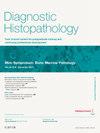人工智能时代的病理学:免疫组织化学和分子病理学的实践见解
引用次数: 0
摘要
人工智能(AI)正在推动病理学的革命,改变传统的工作流程并解决该领域的关键挑战。这篇综述强调了人工智能与免疫组织化学(IHC)和分子病理学(MP)的结合,其在提高诊断准确性、效率和可重复性方面的潜力正变得越来越明显。在IHC中,人工智能工具通过实现诊断和预测标记的自动化和一致分析,为主观生物标记评分、观察者之间的可变性和不断增长的工作量等局限性提供了解决方案。同样,在MP中,AI解决了肿瘤注释、基因突变解释和预测以及多维数据集成方面的挑战,以简化工作流程并增强精准医疗。通过将计算能力与病理学家的专业知识相结合,人工智能有望将病理学重塑为一门更高效、更可靠、更可扩展的学科。然而,在验证、透明度和成本优化方面的持续努力对于充分发挥人工智能在临床病理学中的变革潜力至关重要。本文章由计算机程序翻译,如有差异,请以英文原文为准。
Pathology in the artificial intelligence era: practical insights for immunohistochemistry and molecular pathology
Artificial intelligence (AI) is driving a revolution in pathology, transforming traditional workflows and addressing critical challenges in the field. This review highlights the integration of AI into immunohistochemistry (IHC) and molecular pathology (MP), where its potential to enhance diagnostic accuracy, efficiency, and reproducibility is becoming increasingly evident. In IHC, AI tools offer solutions to limitations such as subjective biomarker scoring, interobserver variability, and growing workloads by enabling automated and consistent analysis of diagnostic and predictive markers. Similarly, in MP, AI addresses challenges in tumor annotation, genetic mutation interpretation and prediction, and integration of multidimensional data to streamline workflows and enhance precision medicine. By combining computational power with pathologists' expertise, AI holds the promise of reshaping pathology into a more efficient, reliable, and scalable discipline. However, continued efforts in validation, transparency, and cost optimization will be crucial to fully realize AI's transformative potential in clinical pathology.
求助全文
通过发布文献求助,成功后即可免费获取论文全文。
去求助
来源期刊

Diagnostic Histopathology
Medicine-Pathology and Forensic Medicine
CiteScore
1.30
自引率
0.00%
发文量
64
期刊介绍:
This monthly review journal aims to provide the practising diagnostic pathologist and trainee pathologist with up-to-date reviews on histopathology and cytology and related technical advances. Each issue contains invited articles on a variety of topics from experts in the field and includes a mini-symposium exploring one subject in greater depth. Articles consist of system-based, disease-based reviews and advances in technology. They update the readers on day-to-day diagnostic work and keep them informed of important new developments. An additional feature is the short section devoted to hypotheses; these have been refereed. There is also a correspondence section.
 求助内容:
求助内容: 应助结果提醒方式:
应助结果提醒方式:


